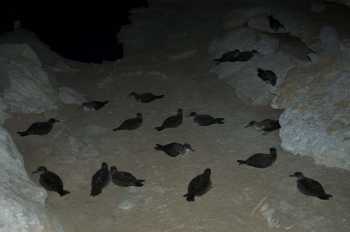The Near Threatened Cape Verde Shearwater Calonectris edwardsii is endemic to the Cape Verde Islands, off the Atlantic coast of Africa. Along with eight other shearwaters of the genus Puffinus and Calonectris it has been identified by ACAP as a potential candidate for listing within the Agreement (Cooper & Baker 2008, Cooper 2010).
The Cape Verde Shearwater's population has been estimated as only 10 000 pairs and is suspected to be decreasing. It faces threats from exploitation of chicks for human consumption (up to 5000 annually, although uncontrolled exploitation may have been largely halted in the last two years) and potentially at least from longline fishing mortality, although evidence appears lacking (Nunes & Hazevoet 2001, Cooper et al. 2003, Brooke 2004).

Selected publications on Cape Verde Shearwaters, 2000-2010
Brooke, M. [de L.] 2004. Albatrosses and Petrels across the World. Oxford: Oxford University Press.
Cooper, J. 2010. A brief review of the conservation status of shearwaters Calonectris and Puffinus. ACAP AC5 Inf 15.
Cooper, J. & Baker, G.B. 2008. Identifying candidate species for inclusion within the Agreement on the Conservation of Albatrosses and Petrels. Marine Ornithology 36: 1-8.
Cooper, J., Baccetti, N., Belda, E.J., Borg, J.J., Oro, D., Papaconstantinou, C & Sánchez, A. 2003. Seabird mortality from longline fishing in the Mediterranean and Macaronesian waters: a review and a way forward. Scientia Marina 67, Supplement 2: 57-64.
Gómez-Díaz, E. & González-Solís, J. 2007. Geographic assignment of seabirds to their origin: combining morphologic, genetic, and biogeochemical analyses. Ecological Applications 17: 1484-1498.
Gómez-Díaz, E., González-Solís, J., Peinado, M.A., Page, R.D.M. 2006. Phylogeography of Calonectris shearwaters using molecular and morphometric data. Molecular Phylogenetics and Evolution 41: 322-332.
Gómez-Díaz, E., González-Solís, J., Peinado. M.A. & Page, R.D.M. 2007. Lack of host-dependent genetic structure in ectoparasites of Calonectris shearwaters. Molecular Ecology 16: 5204-5215.
Gómez-Díaz, E., Navarro, J. & González-Solís, J. 2008. Ectoparasite community structure on three closely related seabird hosts: a multiscale approach combining ecological and genetic data. Ecography 31: 477-489.
González-Solís, J., Felicísimo, A., Fox, J.W., Afanasyev, V., Kolbeinsson, Y. & Muñoz, J. 2009. Influence of sea surface winds on shearwater migration detours. Marine Ecology Progress Series 391: 221-230.
Lima, P.C., Grantsau, R., Lima, R.C.F.R. & dos Santos, S.S. 2002. Notas sobre os registros brasileiros de Calonectris edwardsii (Oustalet, 1883) e Pelagodroma marina hypoleuca (Moquin-Tandon, 1841) e primero registro de Phalacrocorax bransfieldensis Murphy, 1936 para o Brasil. Ararajuba 10: 263-265.
Nunes, M. & Hazevoet, C. 2001. Cape Verde's seabirds in trouble. World Birdwatch 23: 24-26.
Patteson, J.B. 2004. First record of Cape Verde Shearwater (Calonectris edwardsii) for North America. North American Birds 58: 469-473.
Perry, M.V., Bugoni, L. & da Silva Fonseca, V.S. 2000. Occurrence of the Cape Verde Shearwater Calonectris edwardsii on the Brazilian coast. Bulletin of the British Ornithologists' Club 120: 198-200.
Ramos, R., González-Solís, J., Forero, M.G., Moreno, R., Gómez-Díaz, E., Ruiz, Z. & Hobson, K.A. 2009. The influence of breeding colony and sex on mercury, selenium and lead levels and carbon and nitrogen stable isotope signatures in summer and winter feathers of Calonectris shearwaters. Oecologia 159: 345-354.
Roscales, J., Muñoz-Arnanz, J.,González-Solís, J. & Jiménez, B. 2010. Geographical PCB and DDT patterns in shearwaters (Calonectris sp.) breeding across the NE Atlantic and the Mediterranean archipelagos. Environmental Science & Technology 44: 2328-2334.
Note: PDFs of some of the above publications may be found at http://www.gonzalez-solis.com/publications/index.php.
With thanks to Jacob González-Solís for information.
John Cooper, ACAP Information Officer, 9 December 2010

 Français
Français  English
English  Español
Español